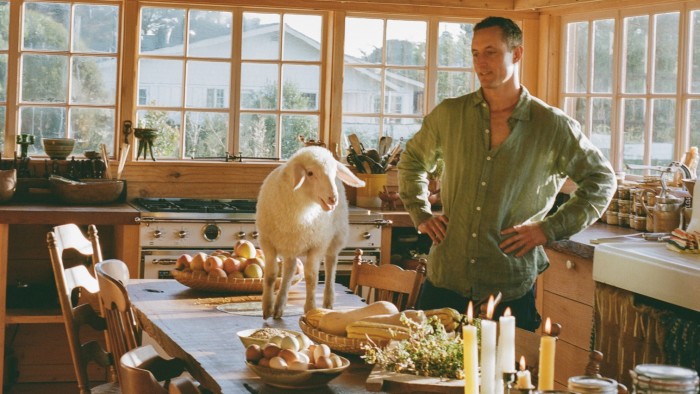Unlock the Editor’s Digest for free
Roula Khalaf, Editor of the FT, selects her favourite stories in this weekly newsletter.
“What I wanted was a land project: a space to plant a garden and ultimately create some kind of healing retreat,” says physician Max Goldstein of Gardenseal Ranch, a near two-acre estate on a peninsula jutting out into the Pacific in Mendocino — a coastal community popular with artists in northern California. What sold him was the fact that the area receives up to 44 inches of rainwater a year and is home to some of the cleanest air in the state, making it an ideal spot for growing ingredients for some of his home-made remedies.
Recently dubbed “LA’s coolest doctor”, the 40-year-old specialist in family and botanical medicine is better known to his patients and fast-growing Instagram following as “Dr Max”. It’s also the name Goldstein is using for his first commercial remedy range.
“Before going to med school, I completed a masters in botany,” he says over the phone from his main home in LA — a Spanish-style bungalow that was once the childhood home of Hollywood starlet Shirley Temple, which has become his medical practice HQ. “I’ve always understood the connection between the natural environment and human health.” As we talk he is bottle-feeding his three new pet lambs: Ramsey, Louise and little Petunia, in preparation for their first road trip up the coast.
Goldstein spends all his free time at the Mendocino ranch. He and his partner, writer and curator Jay Ezra Nayssan, bought the property in 2021, charmed by the cypress trees and ocean views, as well as the 19th-century redwood cabin. Goldstein fell in love with the building’s cathedral-style ceiling, held up only by a few pieces of dimensional lumber. In collaboration with a local art commune, Salmon Creek Farm, they transformed it from a derelict structure to a light, airy home with reclaimed tiles and warm panels of spruce wood.
The garden, meanwhile, has been designed by the duo with support from their “right-hand man” Victor, the gardener. They have added a small rock pond surrounded by lotuses and lilies; a custom Union Ore grill for outdoor fire cooking; and a well house built from old floorboards, which contains the rainwater and grey-water systems serving the property. The four 5,000-gallon-capacity tanks collect about 800 gallons of water for every inch of rain.
In winter, between storms, Goldstein and Nayssan walk around scattering hundreds of wild flower seeds, promising poppies in various shades of red, pink and butter yellow, clusters of bright purple echium, and the occasional Persian red clover in late spring.
When we speak, five giant herb spirals are in bloom, covering half an acre with chamomile, known to promote skin healing, and calendula, the golden, daisy-related perennial sometimes referred to as Bride of the Sun, which features heavily in his remedies.
“It’s our star flower,” says Goldstein, praising its antimycotic properties (it is used to treat fungal infections) and self-sufficiency. “We barely have to water it in the summer because it becomes native,” he explains. “It reseeds itself and captures moisture from the coastal environment.” The bounty is first dried out along his kitchen table, and Goldstein is working with two contract manufacturers in LA to aggregate and extract the herbs to contribute to his bottled products.
The range includes a multipurpose salve made from a combination of arnica, vitamin C-rich sea buckthorn and yarrow, to reduce redness; a calendula flower nipple balm for breastfeeding mothers; and a nappy ointment infused with soothing chamomile. Goldstein has been teasing its release on social media, where he also shares insights into his home clinic and offers health advice, from baby sleeping tips to how to treat a fever.
Born in Los Angeles, Goldstein’s mother was a subsistence farmer in rural Pennsylvania, his father a Harvard academic with a doctorate in sociology. In 2018, he joined the primary care clinic at UCLA and it was there that he began to question the default treatments for conditions such osteoarthritis (often ibuprofen or prescription opioids) or nappy rash (petrolatum-based emollients). He began to trial some of his homemade formulas, distilled from anti-inflammatory herbs such as arnica or melted beeswax, on his patients.
A year ago, he left his post at UCLA to free up some time to integrate botanical medicine into his practice. He uses the ranch as a “field lab” for his growing apothecary of products.
The new range joins a plethora of herbal or herbal-infused supplements and remedies in a thriving global market. The sector, estimated at $90.7bn in 2023 and projected to grow to $160.6bn by 2030, encompasses the recent “shroom boom” in adaptogenic mushroom powders, Erewhon’s sellout Sea Moss superfood, and the many tinctures produced by California’s Sisters of the Valley, a non-religious group of cannabis-growing nuns.
“But I wouldn’t say I’m a homeopath,” says Goldstein. “I’ve just always had a real belief in plants. My dream would be to grow the brand’s philanthropic arm to a point where we could potentially open up a free medical clinic, or sponsor community gardens in schools to connect youth to how plants and food are grown.” He recalls the English folk tale Jack and the Beanstalk. “That’s magic, right? All children should have that experience of seeing seeds grow from small little drops of life into something huge.”
drmaxs.com
Find out about our latest stories first — follow @ft_houseandhome on Instagram
Read the full article here

